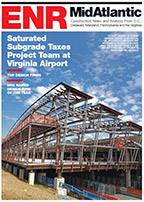Threading The Needle
One of the biggest project innovations was what the design-build team calls "threading the needle." A portion of the Orange Line's 7,000-ft-long bridge over the Trinity River had to cross the waterway's levee system. The crossing spanned 260 ft, without any temporary supports or heavy equipment allowed on the levee during construction, as mandated by the U.S. Army Corps of Engineers. At the same time, a 348-kV power line that was less than 20 ft above where the top wire of the light rail would be was restricting construction, Medina says.
The Kiewit-led team explored a number of structure types before deciding on a dual-track structure that was a three-span continuous unit with span lengths of 145 ft, 260 ft and 145 ft, with four drill-shaft-supported columns, says William Dooley, Parsons' design manager.
The spans are comprised of five segments that are six-girder-wide, 82-in.-deep precast concrete spliced and post-tensioned. The middle girder segment of the levee span is 160 ft, which, at the time of construction, was the longest precast girder ever erected in Texas, according to project officials.
TxDOT has used precast girders extensively, but the deepest TxDOT standard girder is 70 in. "Their conventional reach is 140 to 150 ft, and we reached 260 ft," Dooley says. "Parsons modified the deepest standard girder by increasing the web height by 12 in. and the width by 1 in. The increased web width is used to help with shear capacity and, more importantly, to accommodate the longitudinal post-tensioning tendons located within the web."
The Corps of Engineers also would not allow the design-build team to erect any temporary shoring or crane lifting from the levee itself, Dooley says. "Normally, unrestricted access would have allowed for smaller pieces, a smaller crane and more conventional temporary shoring."
To "thread the needle," Parsons devised shoring that also served as a counterbalance to both support the weight of the girders and hold them down when the erection sequence created an uplift situation on the temporary supports, he notes.
To place the girders, the team constructed on site a 900-ton, short-radius crane with a 300-ft boom "that we could use in tight quarters," Medina says.









Post a comment to this article
Report Abusive Comment